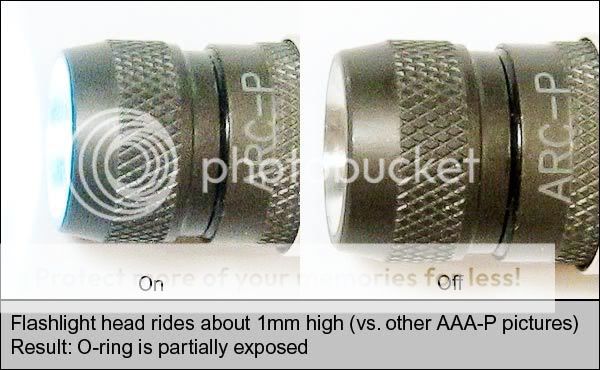Any proper switch has a spring and a pair of contacting surfaces. The contact system is designed so that a predictable contact force is delivered over a known range of travel. Other things come into play, such as size/materials used for the spring (stress relaxation longevity) and surface plating (resistance to oxidation and tarnish). But a reliable contact system starts with a spring.
The Arc has no spring. The foam donut has nothing to do with contact force being delivered. Instead, the torque from your fingers is converted into a compressive force in the axis of the battery. The minimum force is what's required to make enough microscopic surface contact spots that the required current can flow. This is in the order of 25-100 grams, depending on how dirty the contacts are. The problem is, the ARC has no maximum force limitation because there is infinite stiffness (no spring rate).
A screw is capable of exceeding this force by many multiples. When this occurs, something has to give. Arc has intentionally designed the tube and solder ball to have a point smaller than the battery terminals. This way, what gives is the head and tail of the battery due to the relatively large pressure (Force/Surface area, with less surface area).
This isn't a terrible thing, I notice most batteries are usually given a crease upwards at the terminal. But it's permanent deformation, not a spring.
The worst case for the ARC (assuming the LED head doesn't suffer) is what happens when the battery has been dented enough that the minimum force cannot be delivered to the battery anymore. The screw runs out of threads and bottoms out before delivering those grams of necessary force.
It's been suggested in a matter of words "who in their right mind would turn the head past the point at which the light comes on". Do some calculations, it's easy to deliver Kilograms of force to the battery instead of grams with just a tiny bit more torque.
It's not up to the consumer to delicately control the amount of torque to turn on the flashlight. It's our job to use the flashlight within a human range of ergonomics. It's up to the supplier to make sure that range of motion and force is sustainably handled by the device. It could be a ratcheting device, but if you go to this complexity you might as well have paid a real spring.
There is no need to worry about properly designated springs losing their force over time. There are lots of springs out there that last thousands of cycles through heat and fatigue cycling. Yes, they need periodic replacement. But their duty cycle is thousands of times more vigorous than a battery spring. Only cheap disposable flashlights have poorly tempered springs that lose a significant amount of their force over time and from being overextended, a $2 flashlight, not a $40 flashlight.
So now I've exposed some of my expertise. In summary, there is only two good things about not having a spring (1) It's cheaper to make, and (2) You can have a little less length to the device.
Right now I have the battery out of the ARC-P. I turn the head down as far as it screws into the tube. There is still a healthy gap between the top of the tube and the undercut space provided for it. The O-Ring is still in plain view. The tube could definitely stand to be longer. From pictures I have seen on reviews, I can see that it once was a better fit.
For instance, the picture copied below is from Arc's own web site. The overlap shown in this picture is impossible with the flashlight I received from them, even with batteries removed. This picture shows the unit lit, so I must assume they have a battery inside.
If there was an intentional change to the tube length to acommodate a greater variance in battery size and indentation through ON/OFF cycles, there should have been a corresponding change to the location of the O-Ring to keep it in the tube. Or perhaps they made this change, but had more heads than tails (thus I got a mismatched product).






 I'll be keeping my AAA-P now.
I'll be keeping my AAA-P now.